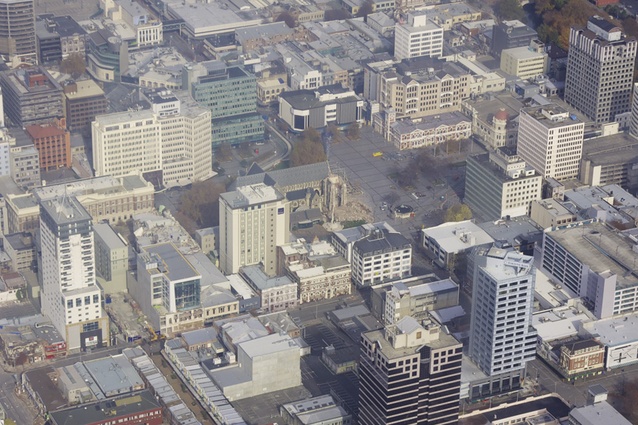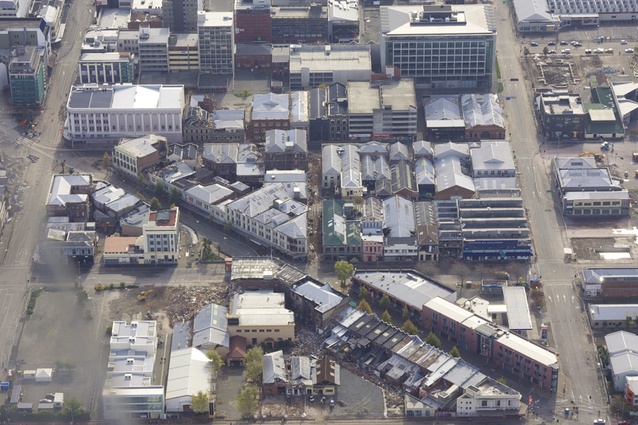Christchurch: Ten thoughts for the city
In response to the Christchurch devastation, Warren and Mahoney have proposed a sequence of strategies to help inform the discussion for the new city.
Forget buildings - its all about the streets. The existing street grid, open spaces and river path are a strong basis for continuity.
However, better connection to the river, presently prevented by traffic flows or poorly sited buildings, should be pursued. Exemplar cities such as Paris and Florence, similarly sited, make the river the focus of the city’s outlook and recreation. We can easily and comprehensively readdress our opportunity for outlook and interaction with the Avon.
Traditional city fabric also offers clues for Christchurch’s street scene. The very best cities (Florence, Rome, Paris, Venice) show that continuous built street edges, where individual buildings are connected rather than stand-alone, contribute to the most successful urban spaces – no “missing teeth” and a continuously active street edge for public interaction and transaction.
The 1850 city plan offers a useful template for reconsidering Christchurch’s more intimate relationship with streets, squares and river. A central market square, an absence of multi-lane one-way traffic routes interrupting pedestrian movement and river access, and strongly articulated central green spaces might be clues to a successful reinvention of the city grid.
Cities are about people. Reoccupation of the city by business, but also by more than business.
A thriving central area where living, work and play can occur is the secret to a rejuvenated CBD. The notion of the central city as solely a centre of business (the “B” of CBD) may now be in question, but not the idea of the city itself. Vibrancy and activity are connected to occupation by people.
The new city environment should be shaped with people in mind. It should envisage 24-hour occupation, be enticing, and welcome businesses, visitors and new residents.
Vehicles should be encouraged, but in such a way as to privilege people and streets, not cars and traffic. Our previous city was perceived as a network of roads; it can now be envisaged as a network of built fabric laced by a closely knit and exciting street scene.
These considerations are not in opposition to commercial constraints, but in step with them.
Back to the future. Heritage is what unites us. An understanding of history helps us imagine the future.
There is no question that our heritage building stock, so long an attraction for both visitors to and residents of Christchurch, has taken a body blow.
However, those key buildings that remain offer clues to the materials and forms that might make up the new city. Our best heritage buildings are simply the result of the good buildings of the day multiplied by elapsed time. The challenge for us is to retain our remaining quality heritage buildings, and to add back new buildings of an equivalent quality.
Safely rebuilding treasured buildings must be a priority. New buildings must anticipate future heritage. We have an opportunity to respond to a shared heritage and incorporate materials and forms appropriate to the character of the new city.
Icons are not the answer. Great cities are collections of built form, where the whole is greater than the sum of the parts.
While it may be tempting to see the future of Christchurch as a stage for new ‘iconic’ buildings, historical precedent would suggest that our money is better spent focusing on maintaining a high level of quality and consistency across all buildings. Containment, vibrancy, intimacy and cohesion are touchstones for high-quality street edges, formed by well-executed façades of well-designed buildings.
The rebuilding of Christchurch should respond to long-established values of proportion, materiality, scale and form.
Consistent density, high intensity. Create a low-rise, dense and intensively utilised CBD, realising the potential for new, designed, open and green spaces.
The adoption of lower height limits will improve the character and visual consistency of Christchurch, while intensifying the life and activity of the city.
Cities of an equivalent population and scale to Christchurch (~400,000), such as Florence and Edinburgh, show that a great city can respond to human scale. While we don’t discount the appeal and desirability of a high-rise experience, Christchurch can benefit from the density, intensity and walkability that low-rise city fabric provides. Long shadows, wind tunnels and an underutilised city perimeter are avoidable if towers are reconsidered in favour of consistent-density, mid-rise street fabric.
Low- to mid-rise city planning also reflects current trends in office and workplace planning: larger floor plates with walk-up proximity to the street and to neighbouring floors are now preferred by tenants to small floor plates in tall towers accessed only by lifts.
High-rise hotels and apartment buildings may still have a place in the city, and offer clues to future conversions for existing high-rise office towers.
The future is green. Sustainability is a bottom line – low rise, low energy, low emissions – a city for new realities.
To build a truly sustainable future, new buildings should anticipate and provide for change over their lifetimes.
Where form may once have followed function, now it will anticipate future functions. Spaces in which people are privileged and where headroom is generous, and that have multiple future uses, are not precluded by a building’s initial design brief or commissioning tenant. Renaissance building fabric in Europe has proved that coping well with changing function is a key to longevity.
Current off-the-shelf technologies and a greater understanding of the need to conserve energy and manage water use allow us to preprogram our new buildings for better performance. High levels of insulation are achievable, and passive ventilation techniques are well understood. Energy use over the next decades by the new commercial buildings of today can and should be much reduced.
Christchurch has an opportunity to become a recognised centre of innovation, technical development and sustainability.
Infrastructure and the city. A cohesive and design-led approach to the transformation of the CBD infrastructure is required.
New thinking can integrate infrastructure processes into the design of the streetscape.
The city can be reenvisaged as a linked network of structures and spaces, and also systems: water management, sustainable energy and transport. We can maximise efficiency by leveraging energy differential, water use and transport links across the city.
The technologies for interlinked energy-harvesting and water management are now well understood and demonstrated in Europe. We can take advantage of this knowledge in the new Christchurch.
Safe investments. New buildings must protect the lives and commercial health of our community.
The new city must be more resilient: safety remains paramount, but important also is asset protection. Is it acceptable that a catastrophic failure in economic terms has accompanied the physical impact on our built fabric and city infrastructure?
Increased security for both life and assets should be investigated, through renewed research and design for safe and durable structures.
The new built environment should better understand the capacity of the population to fund it. Property owners must be able to build and insure their assets cost-effectively for ownership to be sustainable in the future.
Low-rise buildings, potentially on amalgamated titles or undertaken via joint ownership models, can allow individual owners to more easily fund (and transact) their buildings.
Tower blocks representing multi-million dollar investments for large corporate entities may no longer be appropriate in the Christchurch CBD. Exiting such large investments quickly is demonstrably proving difficult for owners, as the market for these offerings is small.
A new, more agile model for building ownership will now be of interest.
High quality, high return. Long-term, strategic thinking – consider the next one hundred years, not just the next ten.
A long-term view suggests that economic viability equates to well-designed, high-quality building fabric. “Value” needs to consider not just initial construction costs, but “whole of life” costs, including operations, productivity and people.
Best returns from future tenants will recognise quality. Poorly executed, low-cost, short-term solutions will be recognised by the market as being sub par and poor value. Such buildings will be commercial failures in the present, and problematic in the future.
The new city should take pains to ensure that built fabric is reintroduced at a standard worthy of the coming decades, so as to be the heritage stock of the future. Similar events elsewhere, both local and international, have shown that high-quality contributions to the city, introduced now, will result in appreciating value into the future.
Think local. And global. The future city is a connected city.
Christchurch can connect to the world through technology, commerce and tourism, and through a compelling story of crisis and rebirth.
We can connect to locals, visitors, investors, returning expatriates and their young families as a “great host”, providing a lifestyle choice in which being the best living environment for families can be a prime strategic driver for the city.
Where, previously, ideas of lifestyle choice were supplementary to the wider pursuit of economic prosperity, we now understand that providing the best living environment for families can be our fundamental point of difference.
Full coverage of this article can be found in the July/August 2011 issue of Architecture NZ. —>—>










